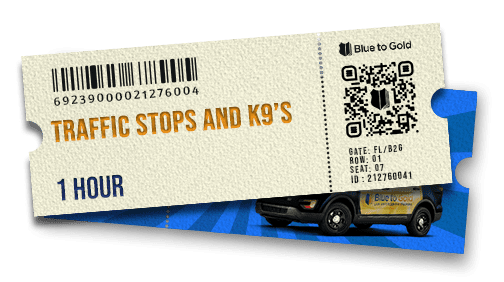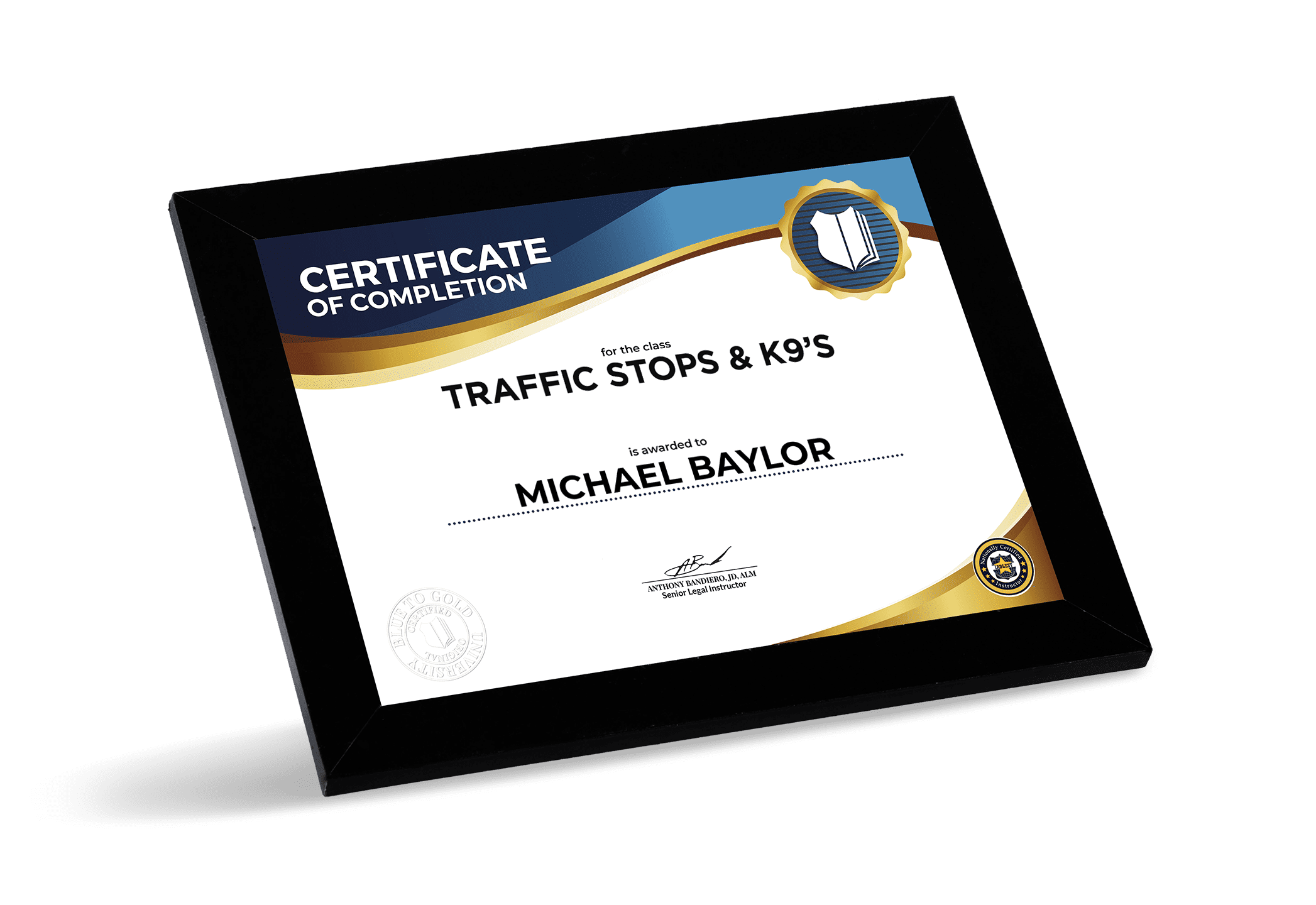Module One: Course Introduction
1. Instructor Introduction
2. Explain the course objection
3. Encourage attendees to ask questions and share feedback with other
4. Explain that certificates will be emailed after the
5. Go over the three disclaimers:
- Laws and agency standard operating procedures may be more restrictive. Blue to Gold is teaching the federal standard unless otherwise stated. Therefore, students must know their state and local requirements in addition to the federal standard
- If students have any doubts about their actions, ask a supervisor or legal
- The course is not legal advice, but legal education. Therefore, nothing we teach should be interpreted as legal advice. Check with your agency’s legal advisor for legal
Module Two: Free-Air Sniffs
1. Case Sample: A dog sniff conducted during a lawful traffic stop that reveals no information other than a substance that no individual has any right to possess does not violate the Fourth Amendment.
2. Legal Rule: However, if the suspect has a reasonable expectation of privacy where the dog is, then a free-air sniff usually becomes a search.
3. To find a visitor knocking on the door is routine (even if sometimes unwelcome); to spot that same visitor exploring the front path with a metal detector or marching his bloodhound into the garden before saying hello and asking permission, would inspire most of us to—well, call the Florida v. Jardines.
4. For example: There is usually no Fourth Amendment search if K9s are deployed around cars in motel parking lots or On the other hand, some courts protect “apartment” hallways the same as a traditional home’s curtilage. Example: TX, CT, NE
= Yes, ND = No
5. Legal Rule: If no RS exists, then calling for a K9 must measurably extend the
6. Takeaway: Here are lawful ways to call for K9: (a) The request takes about +/- 10 seconds (worst option), (b) request make during avoidable downtime, (c) driver consents to K9 sniff, (d) you multi-task and it doesn’t add time (articulate!), (e) back up officer (best option)
7. Legal Rule: Remember, if you run a K9 without reasonable suspicion, the original reason for the stop must
8. Traffic Stops Ends When:
9. Case Sample: Primary officer stopped writing citation to provide 30 seconds of “cover” while handler removed four occupants during free-air Synopsis: The Court of Appeals, Melanson, C.J., held that police officer unconstitutionally prolonged traffic stop by participating in canine sweep, even though officer did not complete citation for traffic violation until after sweep was completed. State v. Linze. Held: Stop unlawfully extended
10. Case Sample: Suspect was stopped for speeding and deputy handed off citation to backup officer to Backup officer finished cite and held on to it for 2 minutes while K9 was deployed around car. Synopsis: The court affirmed a conviction for drug trafficking, holding that the arresting officer did not improperly extend the duration of a traffic stop for a canine sniff. The defendant was pulled over for suspected driving under the influence of drugs or alcohol. The court said that since the purpose of the stop was to determine whether the defendant was driving under the influence, that purpose could not be completed without a drug recognition expert, and the dog alerted prior to the expert’s arrival, the dog sniff did not unreasonably prolong the stop. United States v. Smith. The court denied a drug defendant’s motion to suppress evidence found after a dog sniff of his automobile, holding that the search did not violate the defendant’s Fourth Amendment rights as explained by Rodriguez v. U.S., 135 S. Ct. 1609, 191 L. Ed. 2d 492 (2015). The arresting officer, a highway patrolman and certified narcotics dog handler, stopped the defendant for speeding. When the officer requested the defendant’s registration and driver’s license, the defendant handed him a car rental contract that had expired the previous day, explaining that he intended to extend the contract and that the rental company had instructed him to call later that afternoon (a holiday) to do so. The officer later testified that he found this explanation reasonable. The defendant also provided an out-of- state driver’s license. The officer noticed that the defendant’s hands were shaking. He invited the defendant to come to the patrol car while he took care of a couple of things but allowed the defendant to stay in his own car when the defendant said he would prefer that. The officer testified that it was uncommon for drivers to refuse the invitation to return to his car and that, in the handful of cases where the drivers refused to come back, a seizure or arrest was the usual result.
Once back in his own car, the officer indicated to dispatch that the defendant’s car was a one-day rental, that the car was registered in California, that the driver’s hands were shaking, and that the driver did not want to come back to his car. The officer also relayed the information from the defendant’s driver’s license to dispatch. The officer had not yet finished completing the citation in the car and could have stayed in his car while waiting to hear back from dispatch but instead exited his car and deployed his narcotics-detection dog, on the defendant’s car. The officer testified that he decided to use the dog because the defendant’s hands were shaking and because he was driving an expired rental car and that he would have done the canine search even if the defendant had agreed to come back to the patrol car. The dog alerted to the license plate area of the defendant’s car. The dog was deployed five minutes after the stop began. The officer testified that when a driver came back to his vehicle, there was usually a conversation that would result in a delay, but the deployment would still occur six or seven minutes later. By the time the canine sniff ended, and the officer was back in his vehicle, there was still no report from dispatch. The officer again approached the defendant’s car and asked if the defendant knew of any reason the dog would alert to the car. The defendant indicated that he had a vaporizer and THC oil; however, the dog was not trained to alert on THC oil. The officer then asked if the defendant had luggage in the trunk. When the defendant said that he did, the officer ordered the defendant to get out of his car. Instead, the defendant fled in his car. At that point, dispatch had still not responded. The officer and another trooper who had responded pursued him. Moments later, dispatch informed the officer that the defendant had a nationwide extradition warrant from California related to drugs. After he was arrested and before trial, the defendant moved to suppress evidence discovered during the traffic stop. He did not contest the lawfulness of the initial stop but claimed that the officer lacked reasonable suspicion to conduct the canine sniff. The court denied the motion, finding no need to address the reasonable suspicion issue because the dog sniff did not prolong the stop.49 The court noted that the officer deployed his dog within five minutes after the initial stop and before he heard from dispatch, at a time when he could not be considered to have completed the ordinary tasks related to the traffic stop. There was no indication that the officer unreasonably delayed fulfillment of his responsibilities or advised dispatch to delay, said the court. Held: No violation
11. Case Sample: Federal officer extended a stop to question driver about drugs and called for a K9 without reasonable Driver sued for civil rights’ violation. Synopsis: Detainee brought Bivens action against United States Forest Service officer, alleging that officer violated his Fourth Amendment rights by unlawfully prolonging otherwise lawful traffic stop in order to question him about illegal drugs, call for K9 unit, and perform “dog sniff” of his car. The United States District Court for the District of Vermont, Reiss, J., granted officer’s motion to dismiss for failure to state claim. Detainee appealed. The Court of Appeals held that: (a) relevant inquiry was not whether officer was dilatory in writing citation, but whether his pursuit of unrelated investigation prolonged roadside detention; (b) detainee’s Fourth Amendment right to be free of unreasonably prolonged traffic stop was clearly established for qualified immunity purposes; and (c) detainee stated Bivens claim for Fourth Amendment violation. Vacated and remanded. McLeod Mickle. Held: It was “clearly established” that detaining a driver for a K9 without RS violated the Fourth Amendment. Officer held liable.
12. Pro Tip: If the handler made the stop and wants to hand-off the stop to a backup officer in order to run K9, the transition should be seamless
13. Video: “Running K9”
14. What would you do? What are the legal issues?
Module Three: RS Detentions
1. Legal Rule: Occupants reasonably suspected of narcotic activity can be detained while a K9 is called to the scene
2. What would you do? How long can you detain the occupants?
3. Legal Rule: Occupants can be detained while K9 handler is “diligently” in route to There is no set time…but over an hour is pushing it.
4. Case Sample: Sharpe teaches that in distinguishing a true investigative stop from a de facto arrest, we must not adhere to “rigid time limitations” or “bright line rules,” 470 S. at 685, 105 S.Ct. at 1575, but must use “common sense and ordinary human experience.” Id.; accord United States v. Place, 462 U.S. 696, 709, 103 S.Ct. 2637, 2645, 77 L.Ed.2d 110 (1983) (declining to adopt “outside time limitation” for permissible Terry stop). Several issues and circumstances are deemed relevant to the analysis, including the law enforcement purposes served by the detention, the diligence with which the police pursue the investigation, the scope and intrusiveness of the detention, and the duration of the detention. Held: Because handler was diligently heading to scene, there was no per se violation.
5. Legal Rule: You may tell someone a justified legal truth, and provide options, but never make coercive threats
6. Practical Suggestion: If the officer fairly presents the defendant with a choice whether to consent, the mere fact that defendant for reasons that are particular to him or her, subjectively may feel that he or she has no realistic choice under the circumstances does not ender the consent invalid as “mere acquiescence.” Accordingly, when requesting consent, the officer should ask in a question format (rather than direct or command) and avoid using words or phrases that fairly could be understood by the suspect as requiring compliance. Although and office is not obliged to inform the person explicitly that he or she has a right to refuse, the officer should avoid acts or words that fairly could convey to the suspect that a search will occur regardless of whether he or she consents.
7. Officer had S. for narcotics and asked for consent to search which driver denied. Officer then told her that he would call a K9. Driver changed mind and gave consent. Coerced? Held: No. Telling someone a legal truth is not coercive.
Module Four: Intentional Pre-Alert Touching
1. United States v. Jones, 565 U.S. 400, was a landmark United States Supreme Court case which held that installing a Global Positioning System tracking device on a vehicle and using the device to monitor the vehicle’s movements constitutes a search under the Fourth Amendment.
2. Two Requirements
3. In the first Broadcast BLUE podcast of the 2019 season, retired FLETC Senior Legal Instructor Bruce-Alan Barnard summarizes and analyzes the case US v Richmond. This is a significant decision because it applies the definition of a search established by the Supreme Court in United States v. Jones (Jan 2012) to an automobile on the side of a highway.
4.
5. Video: Running K9”
6. What would you do? Did the K9 conduct a “search” under the Fourth Amendment?
6. Case Sample: An officer directed his canine with his hand to go low-to-high on a truck In response, the canine “jumped up and placed his paws on the vehicle and pressed his nose against” the truck. Synopsis: LeBlanc cast his hand low-to-high. In response, Beny–A jumped up and placed his paws on the vehicle and pressed his nose against Thomas’s toolbox. “The government claims that it is frivolous for Thomas to contend that the dog’s contact with his truck was a Fourth Amendment search. After Jones…, his argument cannot be so easily dismissed.” United States v. Thomas. Held: “Thus, it is conceivable that by directing the drug dog to touch the truck in order to gather sensory information about what was inside, the officer searched the vehicle under the 4th Amend.”
8. What would you do? What if the dog touches the vehicle without handler direction?
9. Legal Rule: Dogs can touch vehicles if: (a) It’s instinctual or (b) Touching or entering the vehicle is a change of behavior equaling P.C.
10. Takeaway: Low is the way to go
11. Case Sample: Driver opened trunk to retrieve paperwork and K9 instinctually jumped in and then alerted. Synopsis: We agree with the district judge that the dog’s instinctive actions did not violate the Fourth There is no evidence, nor does Stone contend, that the police asked Stone to open the hatchback so the dog could jump in. Nor is there any evidence that the handler encouraged the dog to jump in the car. The judge asked the Officer in charge of the dog: “So you didn’t encourage him or discourage him from jumping into the back?” And the Officer replied: “That’s correct. I just let his leash go and let him go where his nose would take him.” In these circumstances, we think the police remained within the range of activities they may permissibly engage in when they have reasonable suspicion to believe an automobile contains narcotics. The examples, while not as intriguing as Stone, provide some answers to when and where police may use drug dogs to sniff vehicles. Held: No Fourth Amendment violation.
12. Case Sample: During free-air sniff handler left door open so K9 could Synopsis: Drug dog’s act of leaping into van that was stopped by law enforcement officers on suspicion of transporting undocumented aliens was not outside scope of Fourth Amendment’s protection against unreasonable searches and seizures, where officers facilitated dog’s conduct by leaving van door open despite absence of any further reasonable suspicion. Held: Encouraging a K9 to enter a vehicle is a Fourth Amendment search.
13. Case Sample: Without prompting, K9 stuck head through open car window to smell for Synopsis: Officer had reasonable suspicion to extend traffic stop for speeding when he noted that appearance of defendant suggested that she was under the influence of alcohol or drugs and that similar individuals driving rental cars to this area were in possession of drugs; extension of stop for six to seven minutes for drug dog to arrive was acceptable. Also, no Fourth Amendment violation where dog, without prompting from handler, stuck his nose through the open car door to smell drugs. Held: This was not a search” under the Fourth Amendment.
14. Takeaway: Remember: Handlers directing their K9 to climb onto or enter a vehicle pre-alert is likely a “search” and may result in suppression of evidence
Module Four: Misc. Issues
1. Pro Tip: If the K9 is deployed based on consent, then there should be evidence that the consent included a K9 sniff.
2. Case Sample: Driver consented to search vehicle when dog was on scene and watched as dog was hoisted up into Held: Driver consented to K9
3. Case Sample: Driver gave consent to K9 arrived 40 minutes later and the K9 was run around car. Held: Driver did not consent to K9 search.
Module Five: Takeaways





